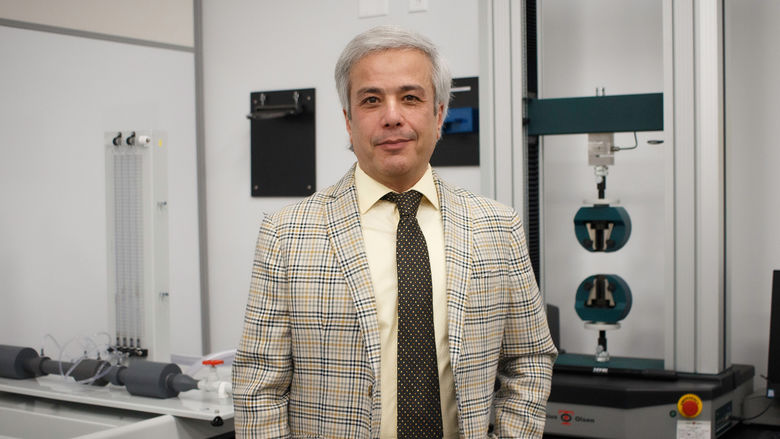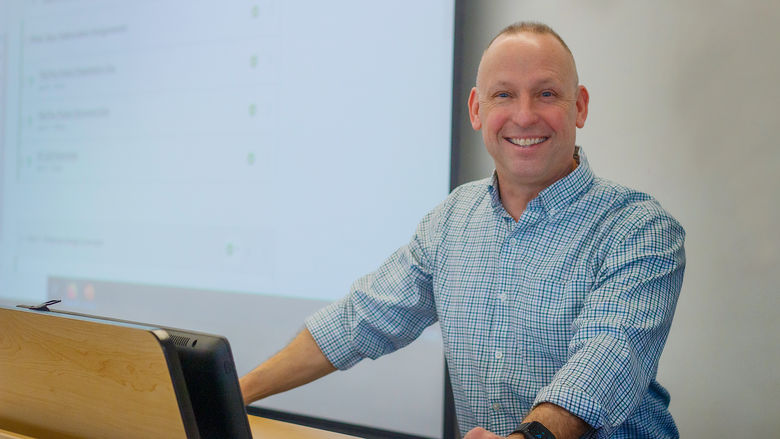

This dialog contains the full navigation menu for this site.

DUNMORE, Pa. – Thanks to a grant from Penn State’s Learning Spaces Leadership Committee, paired with matching funds from Penn State Scranton, Classroom 112 in the campus’ Gallagher Conference Center has received some impressive new technology upgrades.
Penn State Scranton’s Information Technology (IT) department implemented the upgrades in December, which included collaborative worktables, wall-to-wall whiteboards, comfortable chairs, new flooring and short throw projectors with solstice pods at each of the five worktables – which provide an active learning environment with content sharing capabilities for faculty and students.
The classroom has also been revamped with whiteboard material surrounding the entire room, providing the ability to share content in a non-technical way.
“It’s not a room where students are going to be sitting and listening to a lecture,” said campus Director of Information Technology Marilee Mulvey. “It’s a room that’s designed for students to interact with each other and with their instructors and the technology. It's all about keeping the students engaged in different ways in the class and with the course materials.”
Mulvey mentioned that the idea came from the Teaching and Learning Technology (TLT) Department at University Park.
Currently, there are seven total rooms like this at University Park and 14 rooms altogether throughout the Scranton, Abington, Altoona, Berks, Erie, Greater Allegheny, Great Valley, Lehigh Valley, Schuylkill and Wilkes-Barre Commonwealth campuses.
“It’s really a brand-new environment for us. We don’t have another classroom like this on the campus,” Mulvey said.
Thanks to the newly implemented technology, faculty now have new capabilities in this classroom through flexibility in the types of class exercises this room supports.
“When we are looking at upgrading our classrooms, we want to make sure we are enabling active learning in those rooms because of how powerful that can be for our students,” Mulvey said. “The room provides a new look on possibilities of course materials and concepts.”
Faculty members will be able to decide how and when to use the features of the classroom for their course materials. And, faculty can consult with campus Instructional Designer Griff Lewis to brainstorm new ideas for delivering course materials.
Both students and instructors can share their content on the screen and across the classroom – creating a visual aspect to the active learning experience. Users must be authenticated to Penn State Scranton’s Wi-Fi for sharing content.
“When designing our classrooms, we look at providing an updated space for current students and faculty, and we also look at what our prospective students may be experiencing in high school,” Mulvey said. “That way, when they come to Penn State Scranton, they are comfortable in our learning spaces.”
The technology in GCC 112 is in tune with three out of the five senses -- sight, touch and sound.
“Everybody learns in their own unique way,” Mulvey said, explaining how some students like to read, while others prefer to see images or hear things. “This room gives that flexibility for instructors to try to reach different students in their learning styles.”
Like faculty, students can share content in a seamless manner due to the room’s design and flexibility.
“When we find faculty on our campus who are interested in trying something new, that is the absolute best possible scenario,” Mulvey explained. “We support their courses by providing them with these types of technologies to enhance their teaching and increase engagement with the students.”
Because of the room’s flexibility, any academic program can use the classroom’s technology to its full advantage.
“I think it’s a terrific room – all of the changes really enhance the overall environment of the classroom,” Mulvey said, adding that, “we’ve had a very positive response from the faculty so far.”
In fact, a variety of faculty members from diverse backgrounds including the biology, business, kinesiology, meteorology and physics departments have all taken the opportunity to house their classes within the revamped room this semester or are planning on using it in future semesters.
Assistant Professor of Biology Megan Van Etten is looking forward to teaching in the classroom due to its layout, which she believes will help students work more effectively in groups and prepare them for the future.
“Peer instruction is a very effective way to learn a topic and working well in groups is highly sought after by employers. This new technology will help with both aspects,” Van Etten said.
Van Etten also believes that the new technology will help enhance the effectiveness of both teaching and learning styles.
“Just imagine how much effort it used to take to write a paper by hand or look through card catalogs to find papers,” Van Etten explained. “The time it took to write or find papers did not help meet the goals of a course – they were just time-intensive activities you had to get through to achieve the actual learning goal. Technology can help remove unnecessary barriers so that we can focus on our actual course goals.”
Van Etten explained that the technology facilitates sharing ideas and enhances understanding when learned in a small group.
“In practice, this technology lets students easily work on problems together,” Van Etten said. “For more creative assignments, this technology makes it easy to share ideas with one another to create something better than any one individual can create on their own.”
Assistant Professor of Business Nonna Sorokina said the setup of the classroom is beneficial for the groupwork that she assigns her classes.
“Anything can be projected, from real-time video from the phone camera to an Excel file on the computer. Multiple devices can project the same screen side-by-side,” Sorokina said. “Sharing works amazingly!”
Sorokina believes the design of the classroom is essential for any student. “When working on problems, students can see the same screen, write on it, save their findings and notes and so much more.”
Since groupwork is a significant part of Sorokina’s classes, the classroom allows students to connect with the solstice pods to project their work and findings for all teammates to increase efficiency in their activities.
“Imagine you have to discuss verbally or show on a piece of paper to five people at the same time a multi-part formula or a table with six-digit long numbers versus just showing those on a big screen instantly as you go through the activity,” she explained.
“Technology helps us to do more, better and smarter, with less resources. Technology is everywhere, including the workplace, thus it is an undivided part of a quality education. And it is fun!”
She expressed thanks to the campus IT department for offering, promoting and supporting cutting-edge solutions for world-class education. “We are very fortunate to have such an enthusiastic, professional, experienced, open-minded, flexible, friendly and responsive team!” she exclaimed.
Assistant Teaching Professor of Kinesiology Gina Gray’s Introduction to Health and Human Sexuality (BBH146) class is also making the most out of the classroom’s new space.
The setup in the classroom allows for students to be seated in small groups, which is ideal for her class. “We don’t need to spend class time re-arranging the room,” she said. “Using the solstice pods during groupwork helps students to develop teamwork skills and appreciation of the input of other members of their group.”
Gray mentioned that she no longer needs to have information on the screen in the front of the classroom, where it is often difficult for the students who sit in the back to read.
“The Solstice pods allow group members to easily share information when we are doing group work,” Gray said. “The added white board space allows the groups to easily collect their thoughts/answers in one place where they can be seen by the small group and the class at large, if needed.”
Gray emphasized the importance that technology has on students, especially within their educational experiences.
“We, as a university, need to keep up with new technologies in order to recruit and retain students,” she said. “Many job sectors are now technology reliant and if we don’t keep up with newer technologies, our graduates will not be prepared for the workforce.”
Lecturer of Chemistry and Science Theresa Black is using the solstice pods for her class, Ethics of Climate Change (Meteo 133N).
Black has developed her courses in a manner that provides the space and motivation for students to discuss material and learn from each other – and the new setup of GCC 112 is the place for that.
“I have run this particular course in a manner that is about 60% lecture and 40% in-class assignments. These assignments range from article discussions and debates to developing diagrams,” Black said. “The solstice pods allow members of each working group to share screens. Students have used this to pull up the articles which they are discussing, to pull up lecture materials, and to share the assignment screen and collaborate on responses.”
In this first semester of using the solstice pods, Black is allowing flexibility for students’ group assignments. “Some groups will still prefer to turn their assignments in on paper, while others prefer an electronic submission. Some groups will utilize the solstice pods throughout their entire discussion, while others use them in a more limited manner,” she explained. “At this time, I am largely exploring this new use and seeing how it will fit into my course design.”
Black has found it useful for her own pedagogical style to explore technologies that improve the classroom experience.
“We better prepare students for the world after college when we keep up with new technologies,” she said. “The solstice pods were first developed for collaborative meeting settings. I think this can provide an opportunity to introduce this style of cooperation.”
Although Associate Professor of Physics Asif ud-Doula has not housed his classes in the GCC 112 classroom yet, he believes the new technology will allow students to collaborate and communicate more efficiently.
“In this technology, each partner appears to be equally in command of the sessions, making everyone equal, independent partners,” he said, adding that two instances where this new technology would be helpful is in physics coursework -- lab and recitation.
“In physics labs, students are encouraged, if not required, to work in groups. The goal is to learn teamwork, a necessary skill in their future careers. The new technology seems ideal for such collaboration as everyone in the team participates as an equal partner,” ud-Doula said.
“Currently, students use a single computer to analyze and visualize data wherein a single student is in charge of carrying out these tasks. The new technology will change this scenario, and all the students will be able to control and carry out these tasks at the same time upon mutual agreement.”
Similar to physics labs, ud-Doula explained that the technology will provide students to work and solve physics problems together in groups and actively participate throughout recitation sessions.
Although he was a tad fearful of the technology becoming a distraction in the classroom, he has noted that the benefits outweigh those concerns. “Technology often determines how we interact with others in a society,” ud-Doula said. “If we do not adapt to technology that the younger generation of students are familiar with, it is challenging to connect with them.”
Penn State Scranton’s Business Building features a “Wall Street-style” classroom with a working stock ticker along one wall, an amenity aimed at enhancing business students’ educational experiences and perspectives about top tier organizations and the stock market.
Last year, campus IT opted to replace the original model with a newer one. “The old ticker wasn’t working all the time, so it was time to replace it with a new one,” Mulvey said. The new stock market ticker has many innovative features and is set in real-time, which will help business students with their studies.


